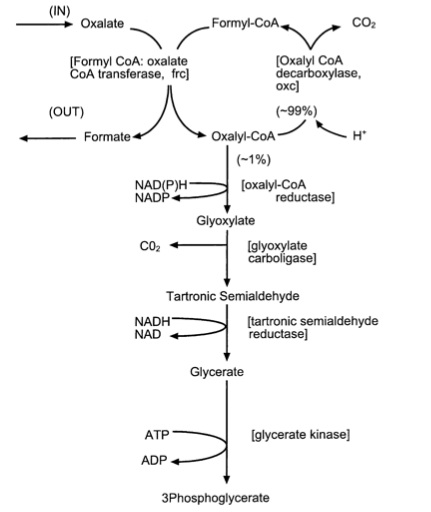Oxalobacter formigenes
Classification
Bacteria; Proteobacteria; Betaproteobacteria; Burkholderiales; Oxalobacteraceae; Oxalobacter
Species
Oxalobacter Formigenes
Description and Significance
Describe the appearance, habitat, etc. of the organism, and why you think it is important.
Oxalobacter formigenes is a gram negative beta-proteobacterium that colonizes the human large intestine (colon) [stewart]. O. formigenes is a strict anaerobe and is thought to be largely important in the metabolism of dietary oxalate [stewart]. The absence of O. formigenes is thought to be a cause of hyperoxaluria and the formation of calcium oxalate stones in the kidney [Siva], and it is thought that O. formigenes may be useful as a probiotic agent for the treatment of these conditions [stewart].
Genome Structure
Describe the size and content of the genome. How many chromosomes? Circular or linear? Other interesting features? What is known about its sequence?
Two separate shotgun sequencing projects are currently under way to sequence the genome of O. formigenes, Neither of these projects are complete (and they each have many unresolved contigs). The length of genetic material currently sequenced is approximately 2.4 MB for both projects, and the GC content of this sequence approximately 50%. The currently available sequence likely does not encompass the entire genome due to toxic or unstable (unable to be cloned) portions of the genome. The genome has not yet been annotated, and the number of chromosomes and characteristics of the genome (such as circularity or linearity) are unknown.
Cell Structure, Metabolism and Life Cycle
Interesting features of cell structure; how it gains energy; what important molecules it produces.
Oxalobacter formigenes is a rod-shaped, gram negative obligate anaerobe. This organism requires oxalate as a source of energy in order to survive [Mittal]. O. formigenes requires oxalate as both a source of carbon and energy. Additionally, it requires acetate as a carbon source, but has no glycolytic pathways, and is thus unable to grow on sugars [Stewart] O. formigenes utilizes an oxalate/formate antiporter system to generate a proton motive force for the production of ATP (energy) [Stewart]. The exchanged oxalate (taken in by the cell) can then be decarboxylated to regenerate formate for export, or further metabolized for the production of glycerate (See Figure 1) [Stewart].
Figure 1: Oxalate metabolism by Oxalobacter formigenes [Stewart]
Ecology and Pathogenesis
Habitat; symbiosis; biogeochemical significance; contributions to environment.
If relevant, how does this organism cause disease? Human, animal, plant hosts? Virulence factors, as well as patient symptoms.
The habitat of this organism is the large intestine of the human gut, and although it is not initially found in the gut at birth, O. formigenes quickly is established in the gut microflora [Mittal]. O. formigenes plays a unique role in the gut microflora in that it is capable of metabolizing 70 to 100 mg per day of oxalate that is ingested in one’s diet [Mittal]. Although soluble oxalate is absorbed in the human small intestine, O. formigenes fulfills the role of metabolizing the remaining dietary oxalate, which can otherwise accumulate, leading to hyperoxaluria and the formation of calcium oxalate stones, which are harmful to the human host [Siva]. This can be considered a symbiosis, in that the organism, a strict anaerobe, is given a safe environment to live and reproduce, along with a steady supply of oxalate to consume. In addition, O. formigenes confers a benefit to its human host. O. formigenes is not explicitly pathogenic.
References
2. Stewart, C.S., Duncan, S. H., Cave, D.R. 2004. "Oxalobacter formigenes and its role in oxalate metabolism in the human gut." FEMS Microbiology Letters. 230: 1-7.
3. Siva, S., Barrack, E.R., Reddy, G.P.V., Thamilselvan, V., Thamilselvan, S., Menon, M., Bhandari, M. 2009. "A Critical analysis of the role of gut Oxalobacter formigenes in oxalate stone disease." BJU International. 103 (1): 18-21.
4. Mittal, R.D, Kumar, R. 2004. "Gut-inhabiting bacterium Oxalobacter formigenes: Role in calcium oxalate urolithiasis." Jorunal of Endourology. 18 (5): 418-424
Author
Page authored by Mark Charbonneau and Ashley Behan, students of Prof. Jay Lennon at Michigan State University.

